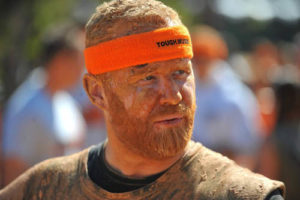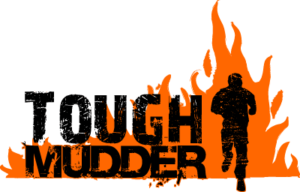
My sister sent me a text message four days before the event. “So what’s your game plan for the mudder? Are you gonna run straight to the cornucopia for supplies or just head out to find a water source?” She succinctly captured my anxiety level.
I still hadn’t selected my outfit. I knew when I signed up that it might be cold in late April, but the warm winter put it out of my mind. Then as the
Mudder
crept closer and the days got cooler, my nervousness grew. I started obsessively checking the weather forecast. It was like a kick to the stomach when I saw expected highs of 45. My internet browsing history from that week reveals a man hysterically searching for “wetsuits,” “tricks for staying warm without clothes,” and “tough mudder cancellation policy.” The fine print warned against showing up intoxicated, ruling out the one useful tip I’d discovered.
I figured clothes would just stay wet (survival experts advise stripping after falling into frozen lakes), and a wetsuit seemed like cheating, so I decided to buy a bathing suit. My only requirements were that it permitted movement and had a velcro pocket for my lip balm (I’m an addict). My only other gear decision had been made months earlier. I planned to run in
vibrams
despite forum warnings about traction.
I don’t really like jogging. For general physical preparedness, a basic level of proficiency is probably a good idea, but for regular exercise I think the risks outweigh the benefits. It pummels the joints and makes athletes slow, predominantly stimulating the slow twitch muscle fibers. But for this event, I needed to do it. I added 1 to 3 runs a week and cut back slightly on my weight training. Leading up to the event, I structured my sessions more like a Mudder. I ran half miles on the treadmill (it’s inferior to the ground, but I needed to be in the gym), alternated with exercises. For example:
Half mile run. 2 minutes of pull-ups. Half mile run. Dead lifts. Half mile run. 4 minutes of plank variations. Etc.
Total sessions lasted over 2 hours. That’s a volume I’d normally never use, but the event can last twice that. To address specific Mudder requirements I worked on my muscle-ups, an exercise that combines a pull-up with a dip. Weighted carries, Turkish getups, box jumps, and sprints also entered the program. Some bear crawls, spidermans, and yoga addressed mobility needs.
We arrived at the site around 9 for our 10:20 start time. The overnight low was in the 30’s, but the day was sunny. After registering, there was little to do but move around to keep warm. I considered taking advantage of the free head shave but waiting on the line was too cold, so I went back to jumping around and cringing. Finally our time came. We had to climb a wall to enter the starting area, a nice touch.
I began the run in old sweats and a T-shirt, which I planned to dump after the first water obstacle. The trail immediately got muddy, a test my vibrams passed easily. They sank deep but slid out effortlessly, perhaps better than a heavier sneaker or hiking boot. The trouble came when the terrain got rocky. Vibrams come in thicker
models
for trail running, but I wore KSO’s, a minimalist design with very thin soles. This required diligently placing every step, never just running on autopilot. This would be a disadvantage for someone going “for time,” but I was more interested in the primal aspects of the event. Feeling the earth beneath my feet seemed more natural.
It quickly became clear that the herd needed thinning. Running the first leg was fun but annoying. Mudders seemed ignorant of basic rules of the road, the etiquette of staying to the right and passing on the left. Teams were especially guilty of traveling abreast instead of single file.
The course did not follow the map provided online, which was fine. The first obstacle was a crawl under barbed wire (this was about as complicated as things would get), a baptism by fire that jolted me into the present. I was now very cold and wet, and sporting scraped elbows. After crawling out I discarded the old sweats and ironic tee. My official costume thus revealed, I ran off. I was chilly in my trunks, but glad to be rid of the heavy, muddy clothes.
Then came the one I’d been dreading, the Arctic Enema, a long crate filled chest high with water and ice. Nothing would get colder than this, so now I would know my limits and whether I would dry afterward. I hesitated briefly then leapt in. It was beyond cold, a temperature my body could not yet compute. Sure I’d iced injuries before, but this was different. No sane individual would remain in this ice. Fighting the urge to scamper over the side, I plunged beneath the wall that divided the crate in two halves. I didn’t pop up right away because I mistook the ice above me for the bottom of the wall. It just felt so heavy on my head. I finally jumped up screaming and lurched for the far wall. Once out and on the ground, I realized why people panic in freezing waters. All thoughts turn to getting out.
Then I started running again. Now I was actually exhilarated. Yes it was freezing, but also such a tremendous blast of feeling. This was a completely new experience, and I knew the worst was over.
After a few minutes I was dry everywhere but under the trunks, and I knew then they were the right decision. Wet clothes, no matter what wickaway technology they employ, cannot dry faster than
human skin
. Perhaps a speedo would be even wiser, except I refuse to go there.
Running along on quiet trails, my teammate and I put several miles behind us, and a few more obstacles. The terrain worsened and my calves bore the brunt of it. Every step required a forefoot strike. Despite my best efforts, I still landed badly on sharp rocks, but nothing caused injury. Training for months in vibrams seemed to have taught my body how to react. If our ancestors did it, I could too.
I went heavy for Hold Your Wood, which requires carrying a log for about ten minutes. It was too wide (or I’m too tight) to carry on both shoulders, so I alternated sides or carried it in my hands, dropping it frequently. Choosing a lighter load would feel too much like skipping the obstacle, and the weight made it more rewarding when I finally dumped it at the end. Along the way my teammate traded with someone suffering under a heavier log, partly in the spirit of camaraderie, and partly for a more appropriate challenge.
I’ve read books like “The Unbearable Lightness of Being” and “Love in the Time of Cholera,” and I think I’ve understood them. They’re about girls, right? Just kidding.
Nick Hornby
The vibrams proved their worth on the climbing obstacles, finding easy toeholds on walls and cargo nets, and staying out of the way in tight quarters. Everest, a tall slippery quarter-pipe, was cake, due in part to my footwear.
The rings and monkey bars were the easiest obstacles of the day. My muscle-up and pull-up regimen helped me out, but I’m also a wiry guy, and my frame is conducive to climbing. The big fellas falling into the water next to me would probably have loved a bench pressing contest afterward.
The most difficult obstacle was the balance beam, a long plank above water. I can’t say if the vibrams helped, but I don’t think they hurt. I barely made it.
Nearing the end, my calves were almost finished. More than three hours after starting, we reached the final obstacle: dangling electrified wires. This one was a let down. They were about as “live” as Ashley Simpson. I’m no masochist, but at least gimme a tickle.
And then it was over. We were handed a beer, t-shirt, headband, and space blanket. We all had a blast, and I would definitely do another.
 |
| I have a headband like this guy |
Was it tough? Sure. I would think the ironman, a strongman competition, a day of bootcamp, and childbirth are probably tougher. The cold wasn’t pleasant (it was about 50), but it was sunny and not too breezy. Had it been raining or cloudy I’m not sure I would have made it. The few instances of wind were awful.
Did I wear the right clothes? The swimsuit was stylish, so yes. The KSO vibrams slowed me down on trails and in the trenches, but I liked the savage element. I had no traction issues. I advise petroleum jelly or body glide for the armpits and other creases, although my teammates didn’t use any and had no problems.
Did I train right? I probably should have run more and practiced carrying logs, but my lifting routine seemed adequate. Maximum strength is not necessary. The website suggests 6 pull-ups as a basic requirement, and I agree.
Was I sore afterward? The Mudder was 36 hours ago, and I am very sore, my calves in particular. I’m also bruised, scratched, and sunburned, but none of it is too painful. It’s a “good” sore. My teammates who wore sneakers have less soreness.
Can anyone do it? No. At 12 miles, it’s almost a half marathon, and many people simply can’t run or walk that far. But athletic people can do it, if they’re like Jeff Bridges and have true grit. But there’s doing it, and there’s doing it well. Like anything educational, you get what you put in. If you walk, choose a light log, and skip the hardest events, you’ll still get your headband, but you’ll get less out of it. Gunning for the lead would be fun, and I may try that one day, but sticking around and helping fellow mudders climb the walls and rope ladders made the entire experience more rewarding. And I’m glad I didn’t lose my lip balm.


